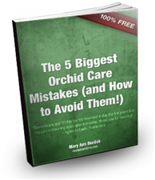 Whenever the leaves of a plant turn a different color, especially orchids, people immediately begin to think that there is something wrong with the plant, but that is not always true. The leaves of an orchid naturally die off in order to make room for new leaves at the top and will yellow in the beginning before falling off. But what happens if your leaves are rapidly turning yellow and are not just the older leaves down towards the bottom of the plant?
Whenever the leaves of a plant turn a different color, especially orchids, people immediately begin to think that there is something wrong with the plant, but that is not always true. The leaves of an orchid naturally die off in order to make room for new leaves at the top and will yellow in the beginning before falling off. But what happens if your leaves are rapidly turning yellow and are not just the older leaves down towards the bottom of the plant?
While some instances of yellowing orchid leaves may simply be a natural process of new growth, there are many others that are a clear indication that something is wrong! Continue reading below to learn what can cause orchid leaves to turn yellow, how to fix them, and how to prevent it in the future!
Some of the Causes of Rapidly Yellowing Leaves:
Overwatering – Whether you’re misting your orchid too often or simply not allowing it to drain properly, too much water is a recipe for disaster when it comes to orchids. The water encourages bacteria and rot which can quickly kill off any orchid. If there are any yellowing spots and rotten spots from over watering, then cut them off and place your orchid in a well-ventilated place to encourage more air flow.
Low Temperatures – Low temperatures, much like higher temperatures, can cause an orchid to stress out. This stress can easily result in all of the blooms being dropped and the buds being blasted off. If an orchid is not removed from a colder environment, it will begin to die. The first stages are yellowing leaves and this will continue to advance to brown until the entire plant is dead.
High Temperatures – Being too hot can easily result in a lot of damage to an orchid plant, even if it is in a prime growing phase. Orchids like optimal temperatures so if you leave it in the heat, yellow leaves will rapidly appear due to the dehydration and overheating of the plant. If this occurs, remove your orchid from the environment and place it in a cooler area so it can recover. Water it normally and avoid fertilizers until it is fully healed.
Burning – Orchids like a lot of indirect sunlight, so many plants that are left in windows may end up with burns on particularly bright days. These burns will often appear as small spots and freckles on the plant and leaves, however they can also show up as yellowing leaves, purple leaves, or, in severe case, blackened leaves. To prevent burning, simply place the orchid in an area with lots of indirect light.
Chemicals – Over exuberance with fertilizers is a common issue with new orchid owners and those who are attempting to nurse a rather poorly orchid. Use very diluted fertilizers on orchids to avoid giving them a chemical burn. These burns will often appear wherever you sprayed and can be anywhere from large yellow spots to black and brown burn spots. Treatment simply involves avoiding fertilizers until the plant is nursed back to health, then using diluted variants afterwards.
Deficiency – If you notice your plant turning yellow from the leaves all the way down to the pseudobulbs, then you may have a nitrogen deficiency. There are other elements that could cause the problem as well, such as an iron deficiency. Using a slow release fertilizer or a balanced liquid fertilizer should help take care of the problem.
Rot – If you are over watering your orchids, not providing enough ventilation, or there is too much humidity in the air, your orchid can develop rot. The rot will likely begin in the roots which, when left untreated, will kill the plant. Since the roots are rotten, the orchid will not be able to soak up the necessary water and it will begin to die by withering. The leaves will wilt and turn yellow, and the blooms will fall off ultimately killing the plant if the affected roots are not cut out.
Bacterial, Fungal, and Viral Causes
If your orchid has an infection that is plaguing it, then yellowing leaves is likely an initial sign and they will turn darker as the infection goes untreated. The symptoms and progression will also depend on the type of infection and its location. Below we have a few of the most common infections for various orchids. These all have yellow leaves as one of the symptoms however the yellow leaves are generally accompanied by a variety of other ominous signs. Check below to see if your orchid has a bacterial, viral, or fungal infection!
Common Infections
- Chlorotic Spot Virus – this begins off as yellow spots that become more defined and pitted as it continues. You can also expect some black spots as well and possibly graying of the area. To treat, remove affected areas, clean remaining leaves, and use appropriate pesticide.
- Leaf Spots (fungus) – These are yellow spots that begin on the underside of the leaf. They will continue to get larger and will commonly have brown spots inside the yellow lesions. To treat, remove leaves and spray with a fungicide.
- Root Rot (fungus) – when there is poor drainage or overwatering, the roots can easily become rotted thanks to a type of fungus that quickly sets in. Leaves will turn yellow as more of the roots become affected and, if untreated, entire plant will brown and die. To treat, quickly identify the rotten roots, remove them, and spray plant with a fungicide before putting it in an area with better drainage.
- Bacterial Brown Spot – while it is commonly associated with brown spots, the leaves of affected orchids will also begin to wither and become yellow as the infection continues. Should your orchid have large brown spots with subsequent yellowing leaves, then begin treating it by removing all of the affected areas. Once done, treat nearby plants, reduce humidity, and spray a bactericide on your plant.
Overall, caring for an orchid is simple once you understand its needs and requirements. Whether your orchid is suffering from adverse temperatures, insufficient watering, too much watering, or an infection of some sorts, there is generally time to save your plant from death if you begin treating it early. Always make sure your orchid has the proper amount of humidity levels and drainage as many of the main causes for yellowing leaves are from there being too much water!
Do you have an orchid that’s turning yellow? Were you able to save an orchid that turned yellow from one of the above causes? Leave us a comment below and tell us about it.
Is your orchid beyond help? Find out if your orchid can be saved.




Why don’t my Oncidiums have the fragrance they had when I bought them? In the store they were really nice but in my home the don’t smell at all.
Well two thoughts. At the risk of sounding silly, were there a lot of other flowers in the store in the same spot? Because they may have contributed to the smell at the time in the store. Also as your flowers age, the scent can get less powerful. Thanks! – Mary Ann
Would there be any possible way I could send you pictures of my orchids by email and you would be able to tell me your best guess of their names because I inherited these orchids.
Have you tried taking them to your local orchid society? I can give it a go too, but I wanted to make that recommendation. 🙂 – Mary Ann
Hi,
My catasetums’ leaves tips are turning yellow. Any advice?
For that type of orchid, it could just be part of its normal growth cycle. They tend to lose all of their leaves until spring.
If you are still concerned, read the descriptions above and see if any of those are applicable. – Mary Ann
I purchased my cymbidium’s and they are in a plastic container in a plastic lined basket.
After sitting them in water for a few minutes I wait until I think all water is drained, then I place them back into the plastic lined basket’s.
I was just wondering should I remove the plastic lining? For more air flow.
Thank you Gabrielle
I’m picturing a solid sheet of plastic on the inside of your basket. If that is correct, then yes I would remove the plastic for more air flow, like you said. You definitely want air to be able to circulate easily. Thank you! – Mary Ann
Hello. Can you please help me with my extremely such orchid. We moved and it got totally neglected through the summer. It’s lost all leaves and the bully bits have turned yellow and shrivelling. Is there any way to bring it back or is it too late.
There’s no harm in trying to help it, but after that long I’m not sure if it can come back. You could try this method and see if it helps. Thanks! – MAB